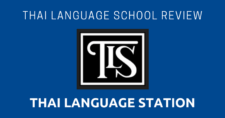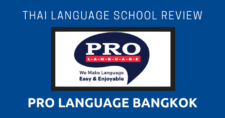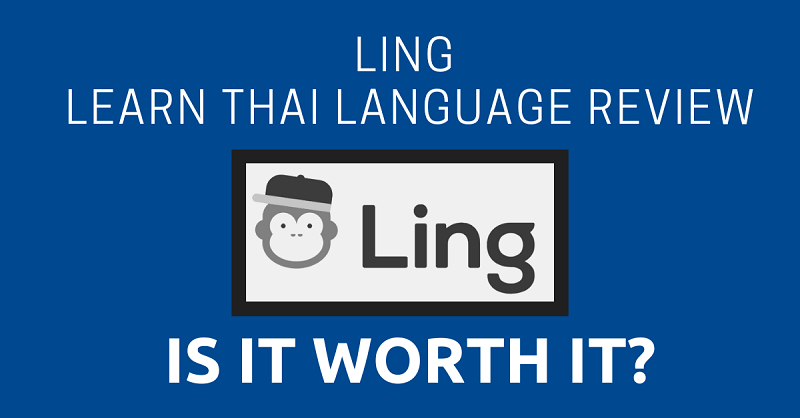
Embracing your host country’s language is not only a sign of respect but also a key step toward forging deeper cultural connections.
In this article, we’ll take a closer look at a tool that you can use to learn the Thai language: Ling. We’ll cover the primary purpose of the app, the specific topics it covers, its teaching methods, the structure of its lessons, subscription options, as well as the advantages and disadvantages.
Additionally, we’ll identify the target audience that stands to benefit the most from using this language learning tool.
Enter your email below to receive our FREE Thai Language Cheat Sheet. It includes a comprehensive list of downloadable PDFs to quickly get you started learning the Thai language. The Cheat Sheet covers everything, from the alphabet, tone marks, and consonant sounds to vocabulary and much more.
Disclaimer: This article may include links to products or services offered by ExpatDen’s partners, which give us commissions when you click on them. Although this may influence how they appear in the text, we only recommend solutions that we would use in your situation. Read more in our Advertising Disclosure.
Contents
What is Ling?
At its core, Ling is an app designed to elevate your language learning, as it provides an engaging and interactive platform rather than rely on conventional language learning methods. Ling offers gamified lessons, featuring mini-games, native audio, transliterations, and simulated conversations to help you start learning Thai quickly.
Ling is conveniently accessible through its website, Google Play, and the Apple App Store, making it easy to use across various platforms.
What You Can Learn with Ling
When I initially began using Ling, I noticed that it’s particularly useful in helping me build a solid foundation of Thai vocabulary and commonly used phrases, which boosted my confidence in handling real-life situations.
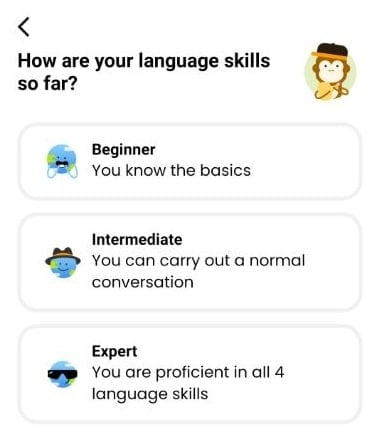
Here’s a glimpse of what you can learn:
Vocabulary: I found the vocabulary section to be particularly useful, covering a wide range of everyday words and expressions.
Practical Communication: One thing I appreciated was Ling’s emphasis on practical phrases, which empower you to engage in meaningful conversations with native speakers. It goes beyond memorization of words; it’s about being able to communicate effectively.
Grammar: Ling dedicates a section to Thai grammar at the end of each unit, providing explanations and insights into the language’s nuances.
Listening and Speaking Mastery: Ling hones your listening and speaking skills through native-speaker audio and voice recognition exercises, ensuring you can communicate with confidence. However, the voice recognition feature was occasionally finicky, and it could be frustrating when it didn’t accurately recognize my voice at times.
Unlocking Literacy: For those who want to read and write in Thai, Ling offers exercises and guidance to learn the Thai alphabet. This is a great feature, but I wished there were more opportunities for practicing writing, as Ling only focuses on individual letters instead of words or phrases.
Learning Method
Let’s take a look at how Ling can shape your language journey:
Interactive and Themed Lessons: Ling’s interactive lessons are engaging and enjoyable. These lessons revolve around specific themes, which I found highly motivating mainly because they ensure that the vocabulary and phrases you acquire are relevant to real-life situations.
Gamified Learning: Ling incorporates gamification elements into the lessons, with features like leaderboards and achievements. These add a competitive edge to your progress, making learning effective and fun. This gamified approach keeps me engaged and committed to achieving my learning goals.
Thematic Units: Ling’s language program is divided into well-defined thematic units. While these units offer structure to the learning experience, there were moments when I wished for more freedom to explore topics outside these predefined units. That said, I like the flexibility of being able to skip themes, which for me is a plus.
Vocabulary Building: Ling emphasizes vocabulary building, which is essential for effective communication. However, Ling is limited to just over 1,000 words (with additional words covered in unsaved content). Although this was a fantastic boost for me to learn new words, I found that using Ling alone won’t let me reach expert-level proficiency.
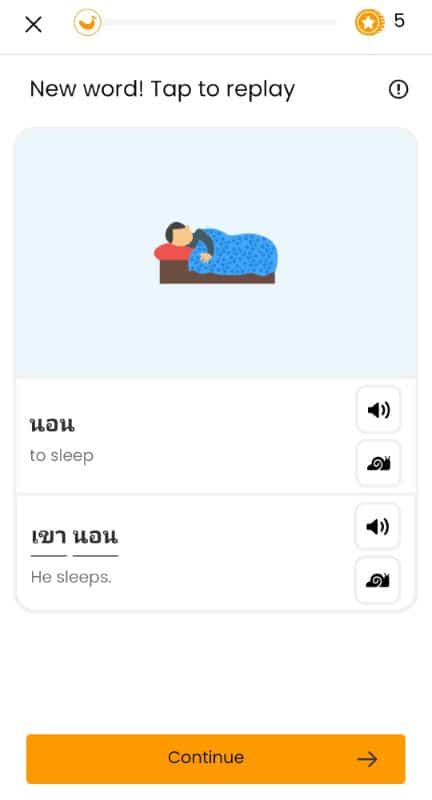
Interactive Exercises: The lessons offer a variety of dynamic and enjoyable interactive exercises, including spelling activities, sentence ordering, multiple-choice questions, and matching tasks. These exercises cater to different learning preferences, ensuring a well-rounded experience for users. This variety helped make the learning experience more engaging for me.
Assessments and Reviews: The app includes unit exams that cover all the materials learned in a specific unit. I highly recommend using it daily to maximize the app’s benefits and reinforce your memory of the lessons.
Chatbox Conversations: One of Ling’s standout features is the chatbox, which offers 20 role-play conversations using audio recorded by native Thai speakers. This function, which provides guided conversations and corresponding responses from a list of sentences, makes the learning experience more immersive.
Visual Learning: Ling’s graphics are clean, simple, bright, and colorful, making them visually appealing and inviting. In addition, the images used in matching exercises aid users in better retaining vocabulary during lessons.
Auditory Learning: The app provides native speaker audio, allowing you to listen to how words and phrases are pronounced by Thais. Additionally, you have the option to hear slowed-down versions for better comprehension, a feature I used a lot and found to be very useful.
Kinesthetic Learning: Ling requires users to interact with the screen to complete tasks. It also offers letter writing exercises that involve physically engaging with what’s flashed on the screen. While this hands-on approach is valuable, note that the app can be quite specific about what it accepts. At times, even a small deviation from Ling’s exact grid path may cause the app to reject the answer. The level of precision required can be frustrating, but it’s a minor drawback in an otherwise enjoyable experience.[SL1]
Lessons
Ling structures its language learning curriculum into five distinct levels:
- Beginner
- Intermediate
- Upper-Intermediate
- Advanced
- Expert
Each level comprises 10 well-defined thematic units, providing a clear roadmap for your language learning journey. The thematic units feature vocabulary and phrases that are relevant to specific contexts, which makes them easy to use in real-life situations.
In terms of interface, Ling is designed to be intuitive and user-friendly. The main dashboard is well-organized, making it easy to navigate through different lessons and units. The thematic units are prominently displayed, which lets you effortlessly track your progress.
Within Each Unit, You Will Find the Following:
Four Lessons: These lessons cover various aspects of language acquisition, which includes the excellent native-speaker audio with helpful slow-down feature and range of exercises mentioned earlier that caters to various learning preferences. However, these lessons might not be as comprehensive as ThaiPod101.
Unit Exams: These exams cover all the topics taught in lessons you’ve taken. They become accessible after you’ve completed the four lessons within each unit. Ling thoughtfully incorporates various question types into these exams, ensuring a thorough evaluation. One noteworthy aspect is the app’s approach to retakes. Ling presents different questions, discouraging rote memorization and actively encouraging a deeper understanding of the content. I appreciate this approach because it promotes a more thorough grasp of the lessons.
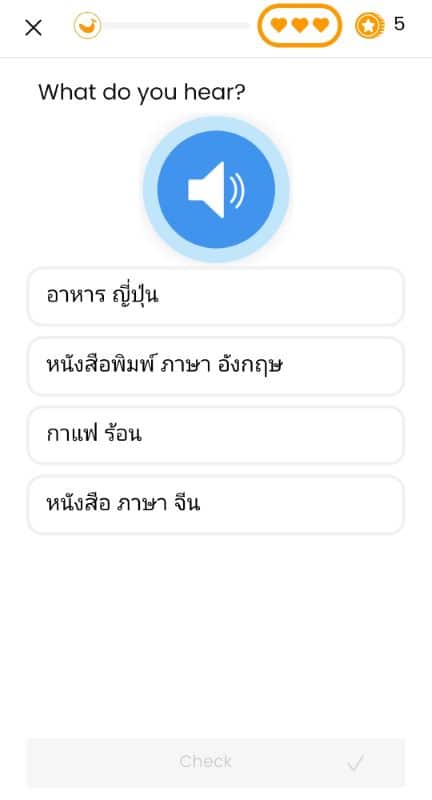
Grammar Insights: After completing the exams, you’ll find a section with brief grammar explanations for the lessons. I found this grammar section to be particularly valuable in clarifying the finer points of Thai, as the implicit nature of the lessons sometimes left me with questions that this section answered.
Review Functions: Ling offers two review functions to help you reinforce your learning. One allows you to review all the units you’ve studied so far, while the other focuses on each individual unit. These review functions are indispensable for maintaining your language proficiency. In my experience, these review functions proved exceptionally useful, but one aspect I wished to see improved is that Ling doesn’t require users to utilize these functions regularly. Given how helpful they are in reinforcing vocabulary and phrases, I encourage users to incorporate these reviews into their language learning daily. It’s unfortunate that Ling doesn’t heavily emphasize the importance of these functions, as those who skip them may not fully harness the app’s potential and could quickly forget lessons learned.
Subscriptions
Monthly Subscription: For $8.99 per month, you gain access to all the language courses available on Ling.
Yearly Subscription: Ling’s yearly subscription plan costs $79.99, offering savings compared to the monthly option. This is the subscription I would recommend, as it allows uninterrupted access to the app’s extensive language courses throughout the year, meaning you can comfortably complete all of the units at the cheapest price.
Lifetime Membership: For a one-time payment of $149.99, you can secure a lifetime membership to Ling. This provides unlimited access to all language courses for as long as you use the app. However, it is worth noting that as you prolong your stay in Thailand and progress beyond the intermediate level, the app’s utility may decrease. Therefore, I recommend opting for this subscription only if you intend to periodically refresh and reinforce the lessons learned.
Ling also has a 7-day free trial, giving you the opportunity to determine if it aligns with your language learning goals before committing to a subscription, which I highly recommend all potential users to do.
Pros and Cons
Before embarking on your language learning adventure with Ling, let’s take a look at its pros and cons:
Pros
Vocabulary: Ling’s vocabulary covers a wide range of everyday words and expressions. It’s an excellent resource for expanding your language skills.
Practical Communication: Ling focuses on practical phrases that empower you to engage in meaningful conversations with native speakers. It goes beyond mere word memorization and equips you with effective communication skills from the beginning.
Structured Learning: The app provides a structured and methodical approach to language learning, making it easy to track your progress and manage your studies effectively.
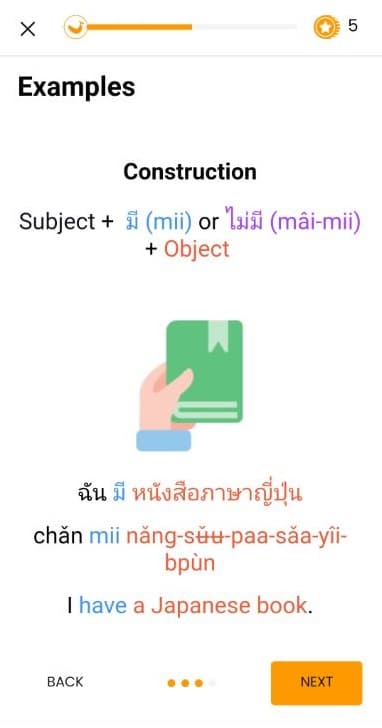
Gamification: Ling incorporates gamification elements, with features like leaderboards and achievements, making learning engaging and enjoyable and keeping users motivated.
Thematic Units: Ling’s thematic units ensure relevance by teaching vocabulary and phrases in specific real-life contexts. The flexibility to skip themes means users can personalize their learning experience.
Interactive Exercises: The app offers a variety of interactive exercises, catering to different learning preferences, keeping the learning experience dynamic and engaging.
Assessments and Reviews: Ling’s unit exams cover all lesson materials, and retaking them presents different questions, discouraging rote memorization and encouraging a deeper understanding. The review section is particularly helpful for reinforcing lessons.
Chatbox Conversations: The chatbox function provides immersive role-play conversations with audio from native speakers. Engaging in these conversations is highly beneficial for honing conversational skills.
Varied Learning Styles: Ling caters to different learning styles. Visual learners benefit from the use of clean and visually appealing graphics, while auditory learners can use native speaker audio with slowed-down versions for better comprehension.
Interface Design: The user-friendly interface and thoughtful organization enhance the learning experience.
Cons
Voice Recognition: The voice recognition feature can be occasionally frustrating when it doesn’t accurately recognize the user’s voice.
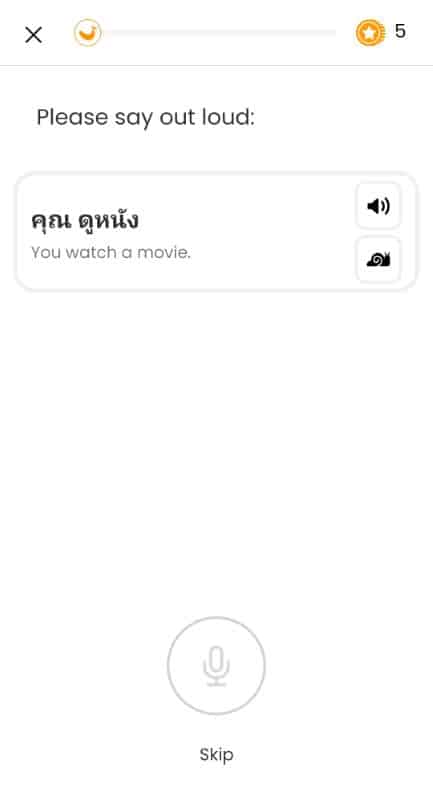
Limited Speaking Practice: Ling lacks face-to-face interaction with native speakers, relying on trial-and-error practice for speaking skills.
Precision Frustrations: Learners may find Ling’s grid-based letter writing exercises frustrating due to the app’s strict requirements to be precise.
Limited Writing Practice: Ling focuses on individual letters rather than words or phrases when teaching writing. This approach doesn’t sufficiently address the complexities of Thai writing, which may leave you wanting more.
Review Emphasis: Ling doesn’t encourage users to use review functions regularly, potentially leading to missed opportunities for users to relearn vocabulary and phrases they may have initially missed.
Abstract Images: Some images accompanying the vocabulary are abstract. A notable instance is the word “opportunity” matched with a star. This abstraction may occasionally lead to confusion, particularly after a prolonged period without exposure to the image and associated vocabulary.
Misleading Proficiency Labels: Although the app labels its proficiency levels up to “Expert”, it is more aligned with learners in the early to intermediate stages of language acquisition.
Who Should Use Ling?
Ling is an ideal choice if you want to build your communication skill to an intermediate level.
It’s also a good option for those who prefer varied learning experience since Ling’s adaptability suits diverse learning styles. Ling’s engaging gamification elements add a competitive edge to your experience, keeping you motivated and eager to progress.
Overall, Ling offers a comprehensive and engaging platform for learning the Thai language.
Despite some minor drawbacks like voice recognition issues and limited writing practice, Ling’s structured lessons, practical exercises, and unique features equip you with the tools you need to begin communicating Thai effectively.






